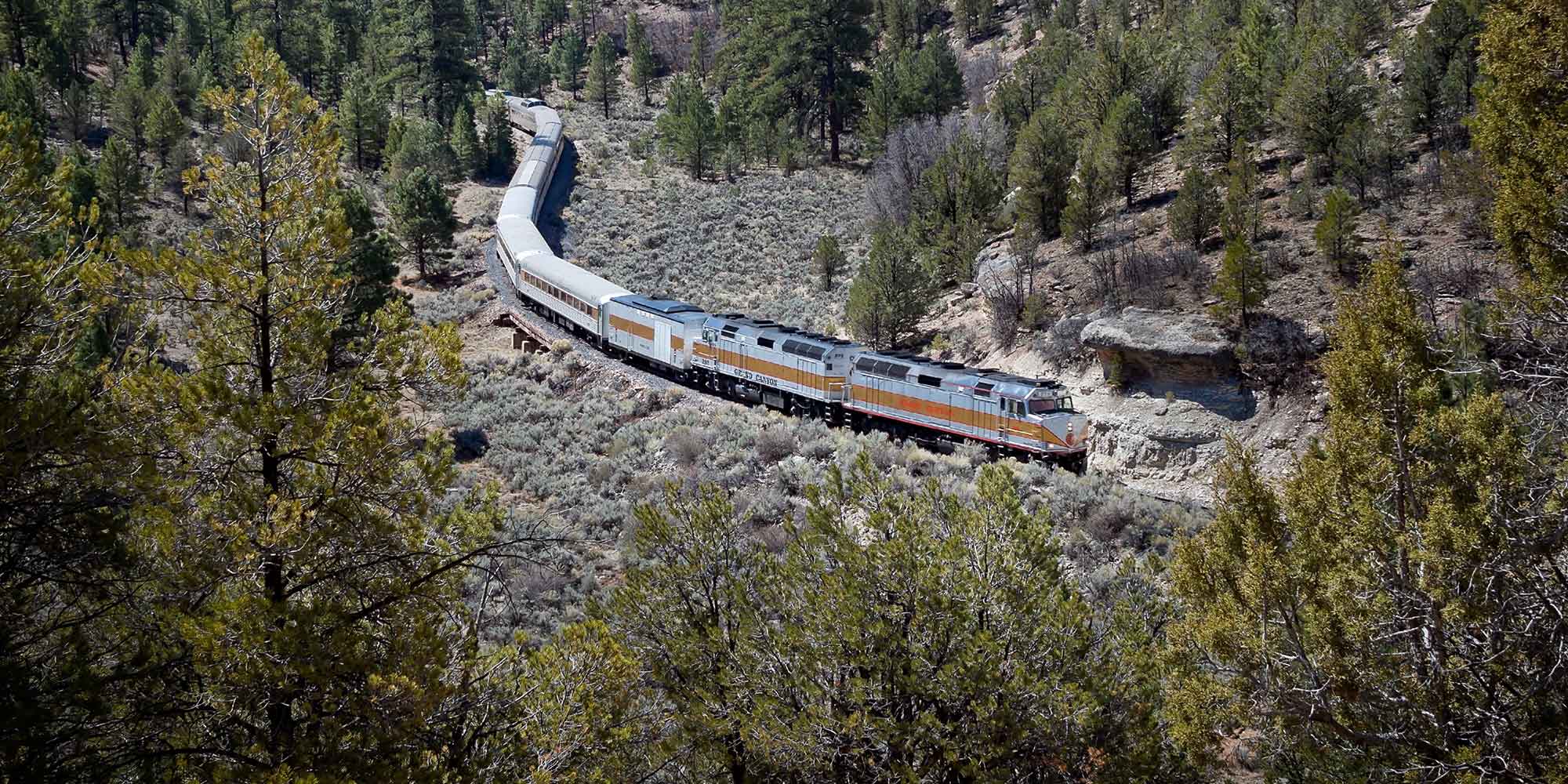Intriguing natural wonders and manmade structures spice up one of the world’s most popular rail excursions
Linking Grand Canyon National Park with the town of Williams, Ariz., the rail excursion delivers fascinating discoveries on its 65-mile journey across the massive Kaibab Plateau.
Of the millions of travelers who visit Arizona each year, most come to discover the beauty, mystery, and magic of one of the seven wonders of the natural world: the Grand Canyon. And one of the best ways to do that is aboard the historic Grand Canyon Railway.
While sodas and spirits, cowboy balladeers and bandits, and vintage railcars ranging from Wild West parlors to sleek observation domes make the journey itself a pleasure, the sight of five landmarks best viewed from the vantage point of the train truly enhance the experience. Here are five to look for as you travel along the route.
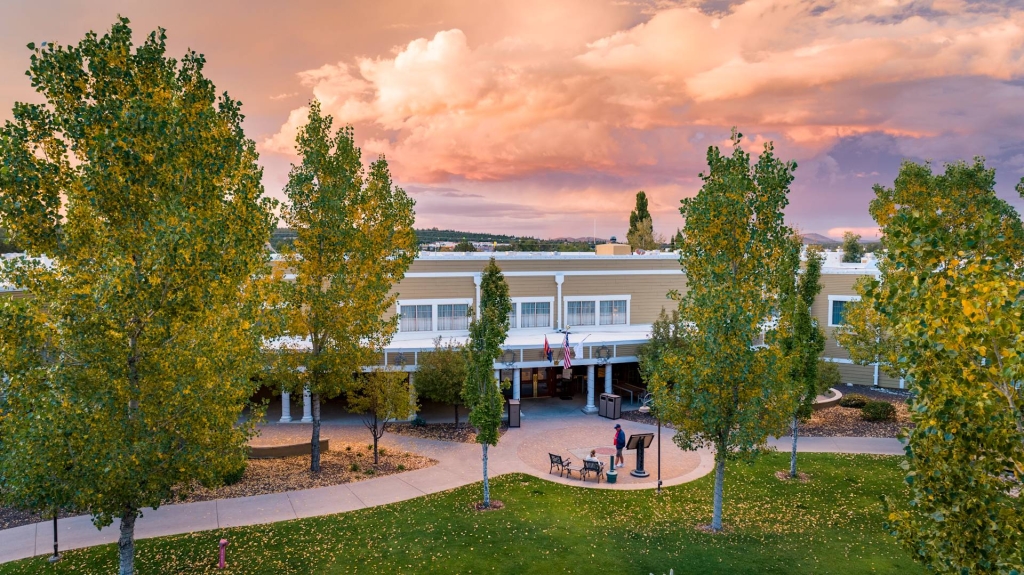
The Fray Marcos Hotel
You don’t even have to roll out of the Williams station to see this historic hotel. Or at least what remains of it.
More than a century ago, Fred Harvey developed a chain of hotels and restaurants — known as Harvey Houses — along the Santa Fe Railway lines. The Fray Marcos Hotel was one of them, built in Williams in 1908. With a tradition of naming hotels after early explorers (in this case, Spanish missionary Marcos de Niza), Harvey’s 22-room hotel was so popular it had doubled in size by 1925.
An island of civility surrounded by a leather-tough town, the then-modern Fray Marcos featured a lunch room staffed by uniformed “Harvey Girls,” a formal dining room, fireplace, cigar stand, and news and photograph room. Now listed on the National Register of Historic Places, the more modern 298-room Grand Canyon Railway Hotel has replaced the Fray Marcos, but guests can still see portions of the historic hotel when they step into the Williams Depot and Grand Canyon Railway gift shop.
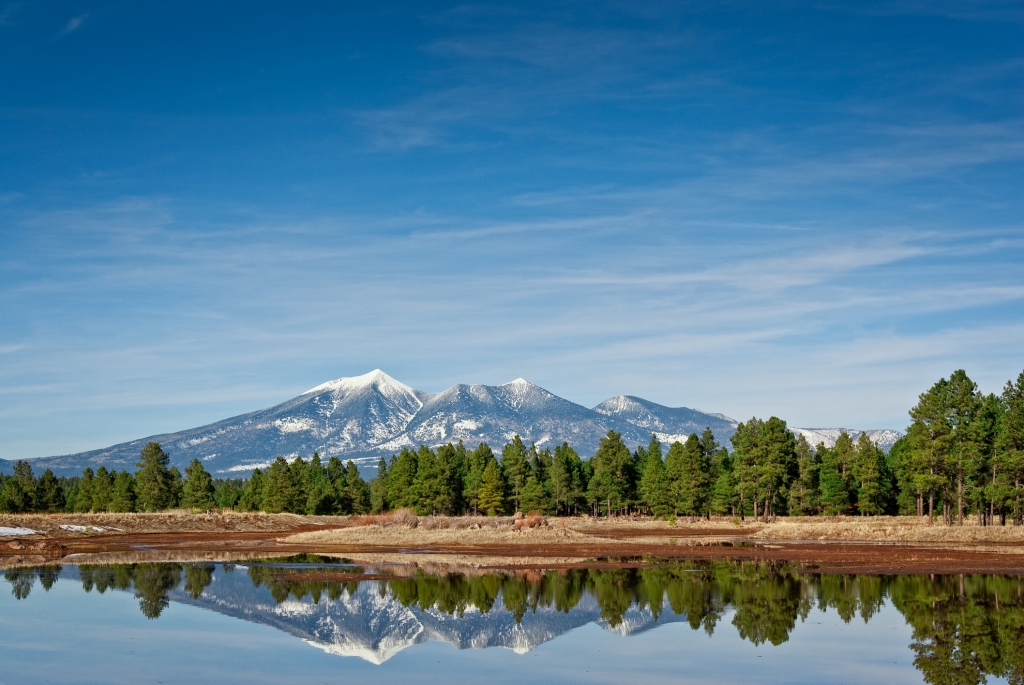
San Francisco Peaks
It’s not every day a train rumbles past a volcano. But in the case of Grand Canyon Railway, it’s twice a day.
Clearly outlined on the broad plain roughly 30 miles east of the tracks, the San Francisco Peaks are the remnant of a dormant volcano that flickered out after eruptions between 200,000 and 1.8 million years ago. At 12,633 feet, the highest point in the range is Humphreys Peak, which scientists estimate likely exceeded 15,000 feet (higher than any point in the continental U.S.) before the pressure of a final eruption blew out the side of the mountain. A cloud of rock and dust added layers of rubble atop accumulated lava flows that covered more than 3,000 square miles around the base of San Francisco Peaks.Several peaks, including Agassiz Peak (elevation: 12,356 feet), surround the collapsed caldera. With snow capping the peaks 10 months a year, it’s a popular destination for skiing in the winter. Summertime visitors can take a ski lift to the 11,000-foot level on Mount Agassiz where a 100-mile panoramic view takes in the land crossed by the Grand Canyon Railway.
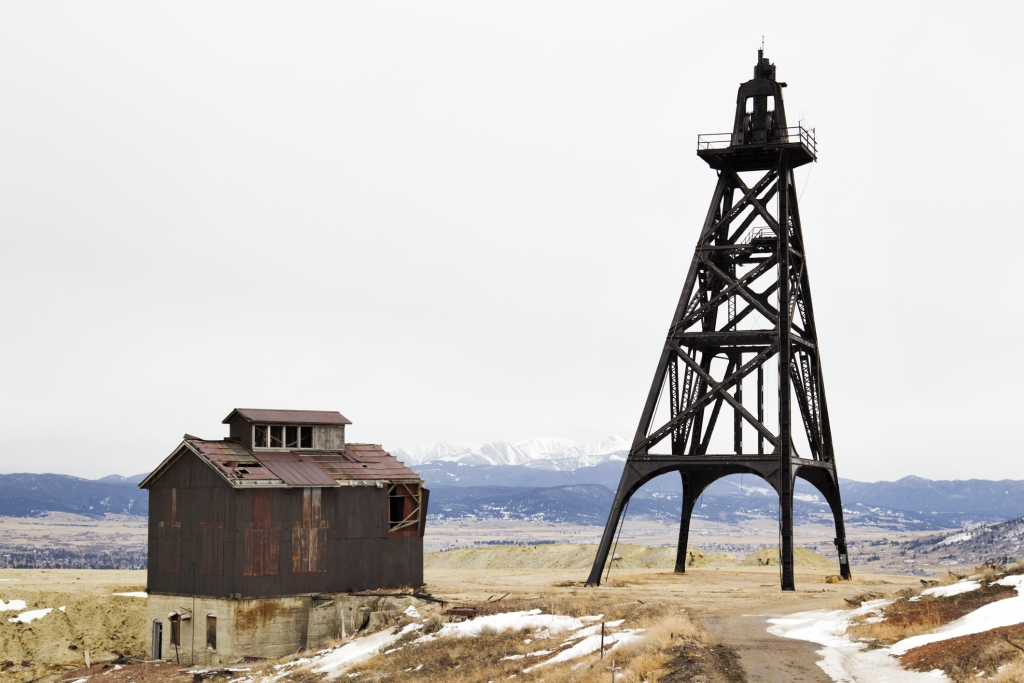
Red Butte/Old Grand Canyon Airport
North of San Francisco Peaks and about 15 miles northeast of the Grand Canyon Railway, a lone red butte rises roughly 1,300 feet above the plain, giving a fair representation of what the region looked like 200 million years ago.
A tidal flat that once covered this area was given a lift due to a shift in the Kaibab Plateau. It brought Moenkopi sandstone and mudstones to the surface, which made it prone to severe fracturing and rapid erosion. Courtesy of a peak coated in a protective layer of basaltic lava, the lone red butte remains as the last remnant outcrop.
What remains from a long-gone era of aviation is the Red Butte Airfield, which became the old Grand Canyon Airport. In the 1920s, aviation entrepreneur Parker van Zandt built a hangar and launched the first commercial air tours over the canyon in a Stinson Detroiter before switching to Ford Tri-Motors — perhaps as a subtle thank you to one of his principle investors: Henry Ford.Long after the last take off, the abandoned hangar and cottages remain.
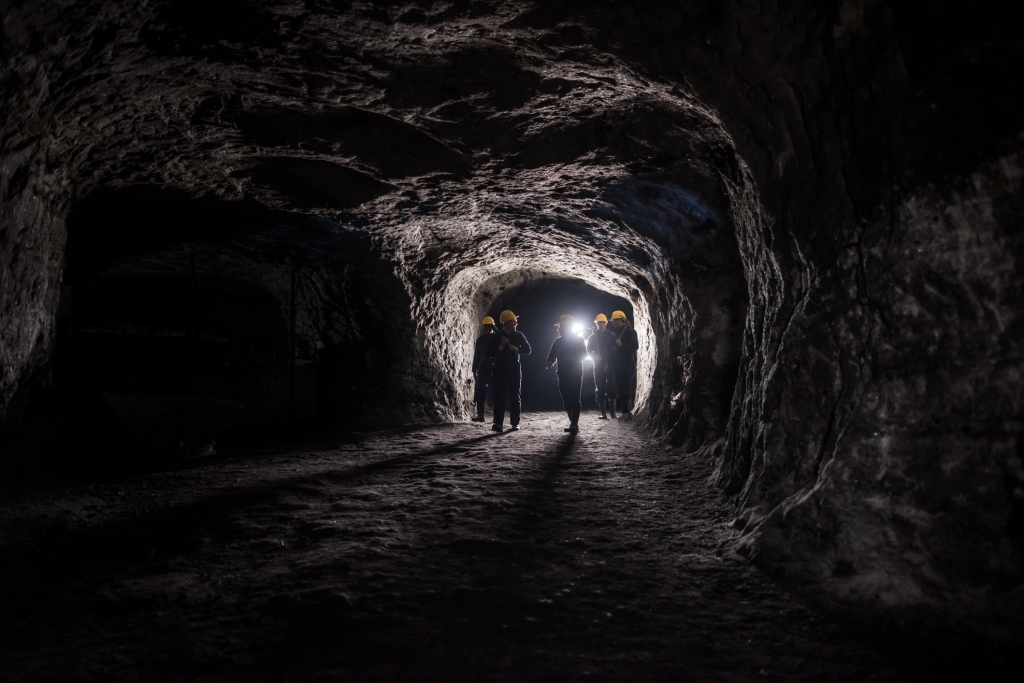
Anita Mines
When mining for ore was a going concern in the region, the railroads naturally rolled to where the mines were. The Anita Copper Company owned one of them.
A three-mile spur line reached the Anita Mines, which was supported by a remote and now-empty company town that once included a section house, bunkhouse, stockyards, forest service headquarters, school, post office, loading ramp, and a wye for turning the trains around.
The end of the mine — and the line — began in 1942 when the company started to close down operations. By the mid-1950s, aside from the stockyard and ore ramp all others structures had been razed or removed. Still visible west of the track, the concrete bunkhouse of the once-thriving operation is easily seen.
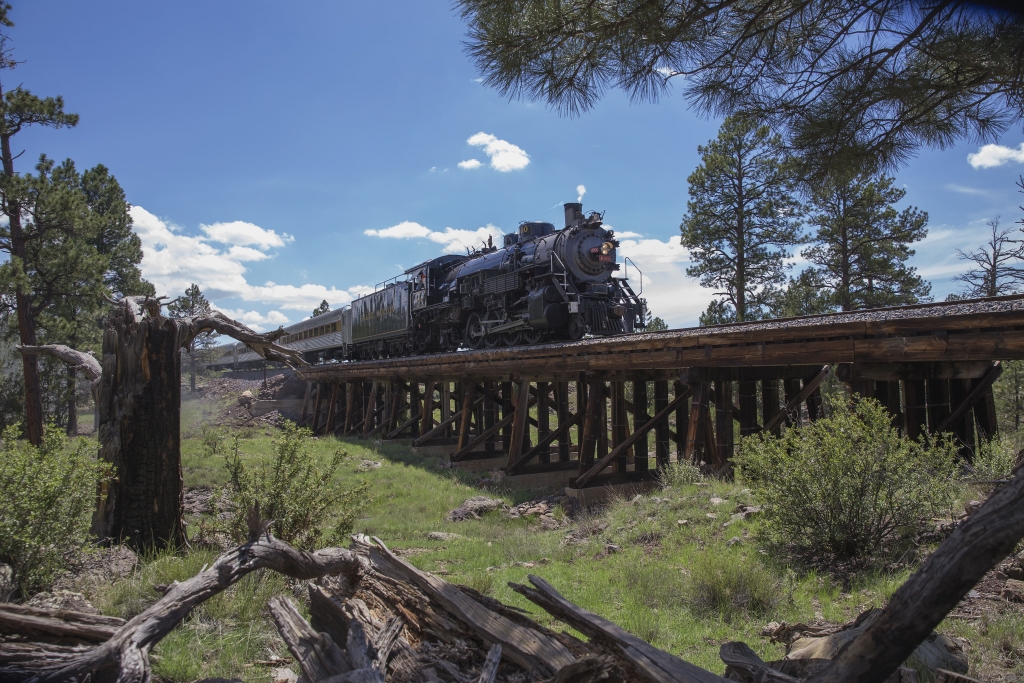
Apex Station
As the train rolls across the summit of the Apex grade — so named because it was the highest point on the Grand Canyon Railroad line — it passes what had been the Apex Station. Following the creation of a passing track in 1901, a rustic station was established and a section house, bunkhouse, and 41-car siding was built to support local residents, namely the construction crews of the old Grand Canyon Railroad.
The small company town lasted for less than a decade — from just 1928 to 1936. Long abandoned and now populated only by scraps and debris, the remains of the concrete bunkhouse sit to the west of the track.
Whenever you’re looking for an excursion that delivers spectacular views and unexpected discoveries, you’ll be on the right track aboard the Grand Canyon Railway.
How to Explore
There’s no better way to make a grand trip grander than on the historic train to Grand Canyon. Travel over 120 round-trip miles through beautiful northern Arizona while being entertained by historical cowboy characters and strolling musicians. The Grand Canyon Railway has been departing daily from Williams, Ariz., since 1901. Spend a night in Williams next door to the train depot at the AAA Three Diamond Grand Canyon Railway Hotel. Just walking distance from quaint downtown Williams and Route 66, the modern hotel has a grand lobby, indoor pool and hot tub as well as Spenser’s Pub with its handcrafted 19th-century bar. Packages with train travel and overnight stays in Grand Canyon National Park and Williams are available. Visit TheTrain.com for more information.
For more travel experiences to Beautiful Places on Earth™ available from Xanterra Travel Collection® and its affiliated properties, visit xanterra.com/explore.


